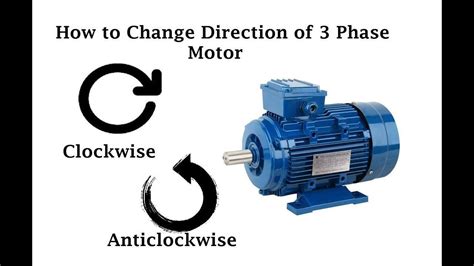How To Reverse The Direction Of An Electric Motor
Ronan Farrow
Apr 02, 2025 · 3 min read

Table of Contents
How to Reverse the Direction of an Electric Motor
Electric motors, the workhorses of countless applications, offer remarkable versatility. One often-needed ability is the capacity to reverse their direction of rotation. This ability is crucial in many applications, from industrial machinery to simple hobby projects. This guide will explore the various methods to achieve motor reversal, catering to different motor types and control systems.
Understanding Motor Reversal Principles
Before delving into the specifics, understanding the fundamental principle is vital. Most electric motors, particularly DC motors and AC induction motors (the most common types), rely on the interaction between magnetic fields to create rotational force (torque). Reversing the direction of either the magnetic field generated by the motor's stator (the stationary part) or the magnetic field produced by the rotor (the rotating part) will effectively reverse the motor's direction.
Methods for Reversing Motor Direction
The method you'll use to reverse your motor's direction depends heavily on the type of motor and the control system in place.
1. Reversing DC Motor Direction
DC motors are relatively straightforward to reverse. They typically require a change in the polarity of either the armature (rotor) or the field winding (stator).
-
Changing Armature Polarity: This is the most common approach. By switching the positive and negative terminals of the power supply connected to the motor's armature, you reverse the direction of current flow, thus reversing the motor's rotation. This method requires a simple double-pole, double-throw (DPDT) switch.
-
Changing Field Winding Polarity (Less Common): In some DC motor designs, reversing the field winding polarity will also reverse the motor's rotation. However, this method is less frequently used and is often specific to certain motor types.
2. Reversing AC Motor Direction (Three-Phase Induction Motors)
Reversing the rotation of a three-phase AC induction motor involves switching the order of any two of the three phases supplying power to the motor.
- Phase Switching: This requires a carefully wired switch that can reconfigure the connections to the motor windings. Incorrect wiring can damage the motor, so carefully consult the motor's specifications and wiring diagram before attempting this.
3. Reversing Single-Phase AC Motors
Single-phase AC motors are more varied in their design. The reversal method depends on the specific motor type:
-
Capacitor-Start Motors: These motors often incorporate a capacitor to assist starting. Reversing typically involves switching the connections of the capacitor. Again, refer to the motor's specifications to ensure correct wiring.
-
Shaded-Pole Motors: These small motors are typically difficult to reverse and are not usually designed for direction change.
-
Universal Motors: These motors can run on both AC and DC and often have a method for reversing similar to DC motors. Check the specific design for the reversal mechanism.
4. Using Motor Drivers & Controllers
Modern motor control systems often employ electronic motor drivers or controllers. These provide a much more controlled and sophisticated method for reversing the motor. These controllers typically offer a simple input (such as a digital signal) to reverse the motor’s rotation. They also usually include features like current limiting and over-temperature protection for improved safety and reliability.
Safety Precautions
Always prioritize safety when working with electric motors:
-
Disconnect Power: Before making any changes to wiring or connections, always disconnect the power supply to the motor to prevent electrical shock.
-
Consult Specifications: Always refer to the motor's specifications and wiring diagram for correct wiring and connection procedures. Improper wiring can result in damage to the motor or even injury.
-
Proper Tools: Use appropriate tools for any electrical work.
By understanding the principles and employing the correct method for your specific motor type, you can confidently reverse the direction of your electric motor, unlocking new possibilities for your project. Remember safety is paramount – always prioritize proper procedures and consult the motor's documentation.
Featured Posts
Also read the following articles
| Article Title | Date |
|---|---|
| How To Stop Carpet Fraying | Apr 02, 2025 |
| How To Stop A Bunny From Chewing Carpet | Apr 02, 2025 |
| How To Start A Mold Remediation Business | Apr 02, 2025 |
| How To Sue A Car Rental Company | Apr 02, 2025 |
| How To Remove A Broken Grease Zerk | Apr 02, 2025 |
Latest Posts
-
How Does Raleigh Weight Loss Center Work
Apr 04, 2025
-
How Does Quick Strike Fly Bait Work
Apr 04, 2025
-
How Does Powderless 22 Ammo Work
Apr 04, 2025
-
How Does Pool Play Work In Baseball
Apr 04, 2025
-
How Does Pay As You Go Electricity Work
Apr 04, 2025
Thank you for visiting our website which covers about How To Reverse The Direction Of An Electric Motor . We hope the information provided has been useful to you. Feel free to contact us if you have any questions or need further assistance. See you next time and don't miss to bookmark.
